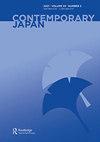Japan’s Disaster Memorial Museums and framing 3.11: Othering the Fukushima Daiichi nuclear disaster in cultural memory
引用次数: 0
Abstract
ABSTRACT With the proliferation of several dozen new exhibits and museums dedicated to this specific disaster, the 3.11 Great East Japan Earthquake, tsunami, and nuclear disaster, can be considered a turning point in the preservation of disaster memory in Japan. Although there is limited research on disaster museums, they play a significant role in shaping cultural memory of 3.11, as they are regarded as reliable, objective institutions of memory. Through analysis of 17 government-established 3.11 museums, this research explores the following questions: How do public disaster museums frame their representations of 3.11, and what official narrative is created within the cultural memory of the triple disaster in Japan? Drawing from analysis of the museums’ mission statements and exhibitions, and interviews with curators and museum staff, we argue that most disaster museums support narratives of overcoming hardships to contribute to a better future, showing continuity with narratives typical of other memorial museums such as WWII, or pre-3.11 disaster museums. In contrast to the commemoration of war and its influence on cultural memory, disaster museums have received relatively little scholarly attention. Yet, these forward-looking messages, combined with tendencies of museums to focus on local disaster experiences and emphasize disaster risk reduction with an artificial separation between man-made disasters vs. natural hazards, contributes to an othering of the Fukushima nuclear disaster in cultural memory, as an outlier in Japan’s long history of disasters. Without full representation of the compound disaster, understanding of 3.11 and the effective transmission of the intended lessons is severely limited.日本灾难纪念博物馆和框架3.11:文化记忆中的福岛第一核灾难
3.11东日本大地震、海啸和核灾难是日本保存灾难记忆的一个转折点,随着几十个新的展览和博物馆的激增,这场灾难可以被认为是日本保存灾难记忆的一个转折点。尽管对灾难博物馆的研究有限,但它们在塑造311的文化记忆方面发挥了重要作用,因为它们被认为是可靠的、客观的记忆机构。本研究通过对17家政府设立的“3.11”博物馆的分析,探讨了以下问题:公共灾难博物馆如何构建其对“3.11”的再现?在日本三重灾难的文化记忆中,官方叙事是如何形成的?根据对博物馆使命宣言和展览的分析,以及对策展人和博物馆工作人员的采访,我们认为大多数灾难博物馆都支持克服困难,为更美好的未来做出贡献的叙事,与其他纪念博物馆(如二战或3.11之前的灾难博物馆)的叙事具有连续性。与纪念战争及其对文化记忆的影响相比,灾难博物馆得到的学术关注相对较少。然而,这些前瞻性的信息,加上博物馆倾向于关注当地的灾难经验,并强调通过人为灾害与自然灾害的人为区分来减少灾害风险,有助于将福岛核灾难作为日本漫长的灾难历史中的一个例外,在文化记忆中留下另一个。如果没有对复合灾难的充分描述,对3.11的理解和预期教训的有效传递将受到严重限制。
本文章由计算机程序翻译,如有差异,请以英文原文为准。
求助全文
约1分钟内获得全文
求助全文

 求助内容:
求助内容: 应助结果提醒方式:
应助结果提醒方式:


